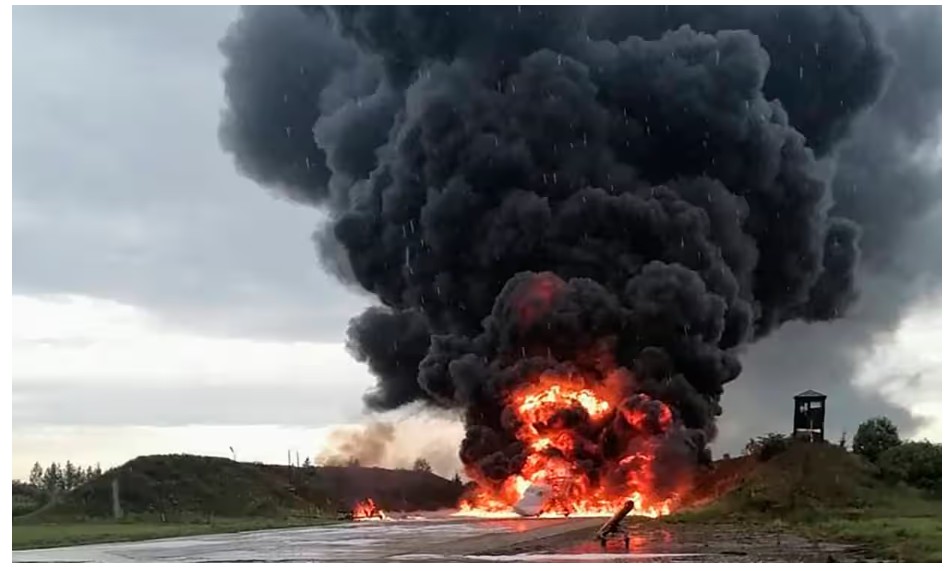In a major escalation of its defense strategy, Ukraine carried out an extensive drone attack deep into Russian territory, reportedly damaging over 40 military aircraft in what could be its most significant aerial operation since the war began.
Sources within Ukraine’s Security Service (SBU) disclosed that strategic Russian bombers, including Tu-95s and Tu-22M3s commonly used for launching missile attacks on Ukrainian targets were among the aircraft hit. According to media outlets like AFP and Kyiv Independent, airfields in Belaya (Siberia), Olenya (in the Arctic Murmansk region), Ivanovo, and Dyagilevo were targeted. An A-50 airborne early warning plane was also allegedly damaged.
Hidden Drones Hit Russian Bases
The drone offensive was part of a year-long covert operation known by the codename “Pavutyna” (Spider Web). According to reports by Ukrainian outlet Pravda, drones were concealed inside mobile wooden sheds mounted on cargo trucks. At the right time, the roofs were remotely opened, allowing drones to be launched toward strategic airfields in Russian rear zones some thousands of kilometers from the frontlines.
The Irkutsk region, specifically the Sredny settlement, witnessed one of the confirmed strikes. Igor Kobzev, the local governor, verified that a military facility had been attacked by Ukrainian drones. Meanwhile, Belarusian media NEXTA shared footage from the Olenya Air Base, showing plumes of smoke and reported explosions, suggesting a possible strike. Though the Russian Ministry of Defense has yet to confirm these details, analysts say this could represent one of the most sensitive hits on Russia’s military aviation infrastructure since February 2022.
This attack comes shortly after Russia’s own massive aerial assault on Ukraine, a bombardment involving 367 drones and missiles, which Ukraine labelled as the war’s most intense aerial campaign to date. That onslaught killed 13 civilians, including three children in Zhytomyr, and caused widespread destruction in cities like Kyiv, Mykolaiv, Ternopil, Kharkiv, and Khmelnytskyi. Ukrainian air defenses intercepted 266 drones and 45 missiles, but infrastructure and residential buildings suffered extensive damage.
In response to those earlier Ukrainian drone strikes, Russia claimed to have intercepted approximately 95 drones over its central and southern territories, with some reported near the capital, Moscow. Russian media outlet RT also released video footage of one such drone strike in Irkutsk, while confirming that both military and civilian emergency crews were deployed to manage the aftermath.
US Pushes Russia for 30-Days Ceasefire
Amidst the military escalation, diplomatic efforts have resumed. The United States, during a United Nations Security Council session, urged Russia to agree to a proposed 30-day ceasefire. The initiative, already accepted by Ukraine, calls for a halt to all land, air, and sea operations, including attacks on infrastructure. U.S. officials described the ceasefire as “Russia’s best possible outcome” and encouraged President Vladimir Putin to pursue peace.
Ukraine’s President Volodymyr Zelensky confirmed that his government will participate in the next round of negotiations in Istanbul on Monday. He stated that Ukraine’s delegation, led by Defense Minister Rustem Umerov, would prioritise achieving a total ceasefire, repatriation of prisoners, and the return of children forcibly taken to Russia. The most recent talks, held on May 16, concluded without resolution. While Russia’s Foreign Minister Sergei Lavrov mentioned that Moscow had drafted a ceasefire proposal, the document has not yet been formally shared with Kyiv.
This latest Ukrainian drone strike signals a significant shift in tactics. Lacking the vast missile reserves of its adversary, Ukraine has invested heavily in drone capabilities. By striking strategic bombers at bases far removed from active combat zones, Ukraine aims to undercut Russia’s ability to launch long-range attacks in the future.
If Ukraine’s claims are officially validated, this operation will stand as the most extensive and damaging drone-based attack of the war, delivering a considerable strategic and psychological blow to Moscow’s military establishment.


